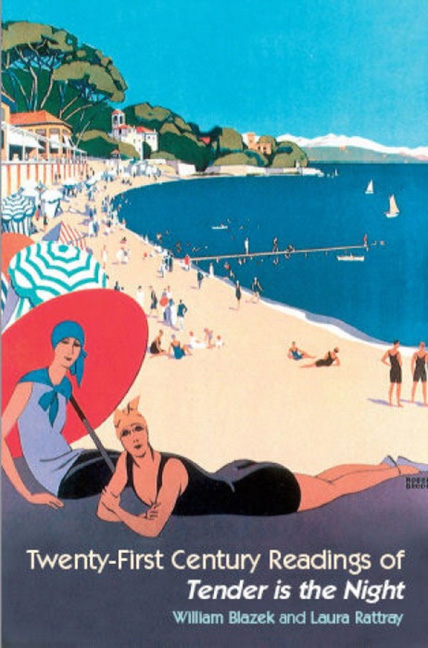Book contents
- Frontmatter
- Contents
- Acknowledgements
- List of Illustrations
- Introduction
- 1 ‘Can't We Put it in Writing?’: Some Short Precursors to Tender Is the Night
- 2 Tender Is the Night, ‘Jazzmania’, and the Ellingson Matricide
- 3 Sanatorium Society: The ‘Good’ Place in Tender Is the Night
- 4 ‘Some Fault in the Plan’: Fitzgerald's Critique of Psychiatry in Tender Is the Night
- 5 An ‘Unblinding of Eyes’: The Narrative Vision of Tender Is the Night
- 6 Si le soleil ne revenait pas: Swiss Clockwork Gone Mad in Tender Is the Night
- 7 ‘A Unity Less Conventional But Not Less Serviceable’: A Narratological History of Tender Is the Night
- 8 American Riviera: Style and Expatriation in Tender Is the Night
- 9 ‘Out Upon the Mongolian Plain’: Fitzgerald's Racial and Ethnic Cross-Identifying in Tender Is the Night
- 10 Gender Anxiety: The Unresolved Dialectic of Fitzgerald's Writing
- 11 Tender Is the Night and the Calculus of Modern War
- 12 Reading Fitzgerald Reading Keats
- Notes on Contributors
- Index
12 - Reading Fitzgerald Reading Keats
- Frontmatter
- Contents
- Acknowledgements
- List of Illustrations
- Introduction
- 1 ‘Can't We Put it in Writing?’: Some Short Precursors to Tender Is the Night
- 2 Tender Is the Night, ‘Jazzmania’, and the Ellingson Matricide
- 3 Sanatorium Society: The ‘Good’ Place in Tender Is the Night
- 4 ‘Some Fault in the Plan’: Fitzgerald's Critique of Psychiatry in Tender Is the Night
- 5 An ‘Unblinding of Eyes’: The Narrative Vision of Tender Is the Night
- 6 Si le soleil ne revenait pas: Swiss Clockwork Gone Mad in Tender Is the Night
- 7 ‘A Unity Less Conventional But Not Less Serviceable’: A Narratological History of Tender Is the Night
- 8 American Riviera: Style and Expatriation in Tender Is the Night
- 9 ‘Out Upon the Mongolian Plain’: Fitzgerald's Racial and Ethnic Cross-Identifying in Tender Is the Night
- 10 Gender Anxiety: The Unresolved Dialectic of Fitzgerald's Writing
- 11 Tender Is the Night and the Calculus of Modern War
- 12 Reading Fitzgerald Reading Keats
- Notes on Contributors
- Index
Summary
The concordances that exist between F. Scott Fitzgerald's 1934 novel Tender Is the Night and John Keats's ‘Ode to a Nightingale’ from 1819, while manifold and previously discussed by other critics, are key for a return to Fitzgerald's novel of personal dissipation and the disintegration of love to unlock a number of its central structuring principles. Accepting the veracity of William E. Doherty's claim that ‘a good deal of Keatsian suggestiveness’ (Bloom 182) runs through Tender, this essay reads Fitzgerald's own reading and adaptation of Keats's famous poem to underscore the intrinsic importance of the ode to Fitzgerald's work. The echoes of ‘Ode to a Nightingale’ that reverberate throughout the novel are multiple and complexly interlinked: the Romantic centre to Fitzgerald's own fictional world tallies readily with the wistful yearning of the Keats poem, which seeks perpetual bliss in the face of irrevocable mortality. Moreover, through the repetition of core words and figures from the poem and the redeployment of some of its central motifs, Fitzgerald reactivates its competing desires for oblivion and the immortality promised by art while simultaneously invigorating his own work with an array of intertextual possibilities.
The increasing troubles of his personal life with Zelda during the time of its construction, twinned with the success of The Great Gatsby, ensured that Tender would be Fitzgerald's difficult fourth novel, and its difficulties remain for readers in the twenty-first century. Central to such difficulty is the novel's diffuse range of subject matter, which ranges across, for example, psychoanalysis, war, prohibition, murder, and Hollywood in a narrative that enfolds personal conceptions of love within a wider historical consciousness. Moreover, disagreement and debate about which version of the novel should stand as the ‘true’ text that Fitzgerald intended adds to its complex choice of subject matter, its intense explorations of incest, adultery and alcohol dependence, and its inability, or indeed refusal, to resolve these questions in satisfactory ways. Throw in Fitzgerald's own nascent interests in psychiatry, the writings of Freud, as well as developing methods of psychotherapy during the novel's nine years of composition and re-drafting, and Tender multiplies its areas of possible contention almost exponentially.
- Type
- Chapter
- Information
- Twenty-First Century Readings of ‘Tender is the Night’ , pp. 204 - 220Publisher: Liverpool University PressPrint publication year: 2007

